
The Melodic Ensemble of the Jungle Babbler
In the heart of the lush, verdant forests of South Asia, a lively and sociable avian species thrives amidst the dense foliage and tangled undergrowth – the Jungle Babbler, scientifically known as Turdoides striata. With its unassuming appearance and gregarious nature, this feathered denizen of the forest adds a delightful charm to its habitat, earning it the endearing title of the “Jungle Babbler” in English.
The Jungle Babbler is a member of the Leiothrichidae family, characterized by its mottled brown plumage, white throat, and distinctive black markings around the eyes. Despite its relatively modest appearance, this small bird possesses a remarkable vocal talent that distinguishes it within the avian chorus of the forest.
One of the most captivating aspects of the Jungle Babbler is its melodious vocalizations, which contribute to the lively symphony of sounds echoing through the jungle. Their calls range from cheerful chirps and trills to melodious whistles and warbles, creating a harmonious ensemble that fills the forest with music. These vocalizations serve various purposes, including communication within the flock, warning calls to alert others of predators, and territorial displays to establish boundaries within their habitat.
The Jungle Babbler is a highly social bird, often found in small flocks of seven to ten individuals. Their sociable nature extends beyond mere companionship, as they engage in cooperative behaviors such as foraging, nesting, and caring for young collectively. This cooperative breeding strategy ensures the survival and well-being of their offspring, highlighting the importance of social bonds within the flock.
In addition to their vocal and social attributes, Jungle Babblers play a vital ecological role within their ecosystem. As omnivores, they have a diverse diet that includes insects, fruits, seeds, and nectar, making them important contributors to seed dispersal and pest control. Their presence also attracts other bird species, creating a diverse and dynamic community within the forest.
Despite their adaptability and resilience, Jungle Babblers face threats from habitat loss and fragmentation due to human activities such as deforestation, urbanization, and agricultural expansion. As their natural habitats diminish, populations decline, and the rich biodiversity of the forest is put at risk.
Conservation efforts aimed at preserving the habitat of Jungle Babblers are crucial for ensuring their continued survival. Initiatives focused on habitat restoration, sustainable land management, and community engagement can help mitigate the threats facing these charming birds and safeguard the ecological integrity of their forest homes.
In conclusion, the Jungle Babbler, with its melodious song and sociable nature, adds a delightful charm to the lush forests of South Asia. As stewards of the natural world, it is our responsibility to protect and preserve the habitat of these enchanting birds, ensuring that their melodious ensemble continues to resonate through the jungle for generations to come.





